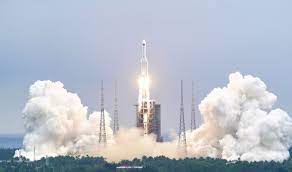Agencies-Gaza post
International Astronomy tells when Chinese rocket debris, danger zones hit
The International Astronomy Center announced a new update on the debris of the Chinese rocket expected to fall on Saturday, July 30.
The rocket’s shooting date will be 17:22 GMT today.
He emphasized that all areas of the Arab world outside the fall zone may change in the following updates. All areas below the red and green lines are candidates for debris to fall over.
On July 24, 2022, China launched a Long March 5 (CZ-5B) space rocket, carrying one of Wentian’s main pieces to dock with the Chinese Space Station (Tiangong).
This rocket consists of four large jet propulsion boosters and only one major stage. The main phase now revolves around the Earth every 89 minutes.
As this piece orbits the Earth and is an industrial one, it is now called a satellite, a space debris type. Contrary to what is exaggeratedly common, the topic of satellite falls towards Earth is frequent on a weekly basis, but what characterizes this fall is a larger piece than usual.
This debris is 33 meters long, 5 meters in diameter, and weighs approximately 21 tons, orbiting the Earth at an average speed of just over 28 thousand kilometers per hour!
What happens when satellites fall towards Earth is the following:
At an altitude of 120 km, the satellite suffers from severe friction with the atmosphere. Its temperature rises and begins to disintegrate.
At an altitude of 78 km, the satellite explodes due to the intensity of pressure and heat and remains on fire until an altitude of about 50-40 km.
During this journey, 120 km to 40 km is seen in the sky as a very bright and flaming object and consists of several luminous pieces! Then the light disappears and his fall towards the ground completes a free fall and you can’t watch it until it hits the ground!
Due to the above, only 10% to 40% of the initial satellite mass reaches the Earth, but because of the size of this large debris, the remainder of it may pose a risk to the place to which it will fall exclusively. Since water constitutes 71% of the Earth’s area, it is also 71%.
No one in the world can know where and when this wreck will inevitably fall, as this prediction process is marred by many






















